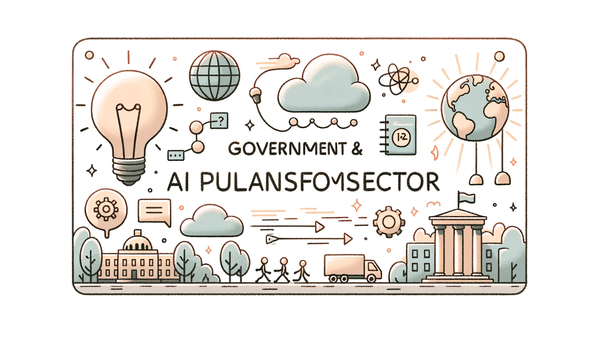AI's Growing Landscape: From Billion-Dollar Deals to User Data Consent

The brave new world of AI isn’t just about technology—it’s about reshaping narratives, empowering users, and redefining industries through bold proposals, strategic moves, and innovative partnerships.
Empowering Users in the AI Data Era
At the recent SXSW conference in Austin, a remarkable initiative has stirred conversations across the tech industry. Bluesky’s CEO, Jay Graber, proposed a novel framework that gives digital users explicit control over how their data is used for generative AI. Imagine if every online post came with a customizable “permission slip”—this is the heart of Bluesky’s plan. The system is being modeled in a way very similar to the familiar robots.txt mechanism that websites use to manage web crawler access. By allowing users to specify their consent levels at both account and post levels, Bluesky is setting the stage for a new standard in ethical AI data usage.
This proposal is a pivotal step forward in the broader conversation about data privacy and ethics in the age of AI. As companies worldwide seek to capitalize on the vast resources of user-generated content, the need for transparent frameworks that respect individual rights is more urgent than ever. The open availability of Bluesky’s proposal on GitHub has not only invited community feedback but also encouraged industry-wide dialogue. If widely adopted, this could serve as the blueprint for future regulations and best practices.
This emphasis on user agency not only sets a higher ethical standard but also paves the way for more collaborative approaches between tech companies and regulatory bodies. For more details on this groundbreaking user-consent framework, check out the full discussion on the original TechCrunch article.
Strategic Investments: The OpenAI and CoreWeave Play
Shifting gears from ethical frameworks to high-stakes strategic investments, another landmark move has captured headlines. OpenAI has committed nearly $12 billion over five years to CoreWeave, a cloud service powerhouse now focused on AI. This deal is more than just a massive transaction—it is a strategic chess move. CoreWeave, with its network of over 250,000 Nvidia GPUs, has transitioned from its origins in crypto mining to become a central player in powering AI workloads. The infusion of capital is designed to not only satisfy OpenAI’s increasing computational needs but also to diversify CoreWeave’s client base.
Historically reliant on a few major clients, including a substantial portion of its revenue from Microsoft, CoreWeave’s pivot highlights the rapidly changing landscape of digital infrastructure. The hefty investment, which also included a $350 million equity stake, signals a move towards a more competitive environment, with OpenAI positioning itself closer to rivals like Microsoft. It showcases the intensifying race for supremacy in the ever-evolving AI domain.
With this deal, the dynamics among tech giants are shifting. The competition is not only about who has the fastest processing unit or the most advanced algorithm—it is also about who can master the art of strategic partnerships and investments. For an in-depth look at the wider implications, you might explore further discussions on industry shifts in our related piece AI Innovations and Their Impact on Industry Dynamics.
AI Transforming Traditional Industries
Artificial intelligence continues to be a catalyst for transformation across traditional sectors, including real estate finance. In a collaborative venture, HomeVision joined forces with Restb.ai to elevate collateral underwriting processes in the mortgage industry. By integrating advanced computer vision through HomeVision's MIRA platform, discrepancies between property images and appraisal data are being rapidly identified—ushering in a new era of precision in property valuation.
The integration of optical character recognition, natural language processing, and machine learning allows for a detailed analysis of property conditions and compliance checks. This partnership not only mitigates risks in loan underwriting but also enhances the efficiency for lenders, appraisal management companies, and individual appraisers. It is a prime example of how AI is transcending its traditional bounds and reinventing industries that once relied solely on human judgment.
The adoption of AI in this domain highlights the potential for reduced errors and smoother regulatory processes. It’s fascinating to see such a blend of technology and traditional business models, echoing the narrative of digital transformation that’s prevalent throughout modern industries. For further insights on how AI is making such innovative inroads, our analysis piece on How AI's Landscape is Shaping Up offers broader perspectives on the challenges and opportunities in the current AI revolution.
Decoding Motivations: AI in Health and Well-being
An intriguing twist in AI research reveals that when it comes to exercise, appearance, rather than health, is the primary motivator for many. A recent AI-driven study found that aesthetics weigh more heavily on people's decisions to exercise, overshadowing traditional health-driven incentives. This discovery has far-reaching implications, not just for the fitness industry but for how health messages are crafted.
While the health benefits of physical activity have long been championed by medical professionals and institutions, the reality on the ground is that visual appeal often takes precedence in influencing behavior. This divergence between health and aesthetic motivation calls for creative approaches in public health messaging—perhaps aligning the pursuit of beauty with wellness goals could foster more sustainable exercise habits.
The findings prompt us to re-evaluate our understanding of motivation itself. One might recall a timeless notion that "beauty is in the eye of the beholder," but here, beauty becomes a driving force in ensuring public engagement with fitness. For a broader exploration of how AI-driven insights are challenging our notions of motivation and behavior, consider our comprehensive overview in Beyond the Buzz: The Evolving Landscape of AI in Health Care and Beyond.
Revolutionizing Operations: AI in Action at Samsara Inc.
In the industrial sector, AI is playing a transformative role in streamlining operations and enhancing productivity. Samsara Inc. has experienced a remarkable 33% increase in annual recurring revenue, powered by its AI-driven solutions in fleet management and operational analytics. By integrating features such as AI Dash Cams and advanced data analytics, the company has connected operational data to its cloud platform—dramatically improving the operational efficiency of over 203 big-spending customers.
This digital transformation is not just a matter of improved analytics; it represents a seismic shift in how technology interacts with operations. As industries worldwide face challenges of timely data processing and operational scalability, Samsara’s approach provides a template for leveraging AI to achieve growth and enhanced customer service. The company’s success story is emblematic of a larger narrative where AI is not merely a tool for automation but a robust platform for innovation.
On a global scale, this evolution in AI is interlinked with broader economic strategies. For example, China’s state-backed fund aimed at fostering technological advancements and the U.S. initiatives like the $500 billion Stargate project are clear indicators that governments are taking note of AI’s potential to drive economic growth. The interplay between these national strategies and corporate success stories underscores the transformative role of AI in modern industry. Further details and insights on such dynamics can be found in our internal feature Samsara’s Transformation: AI's Impact on Operations.
High-Stakes Exits: The Moveworks Saga
The world of venture capital in AI startups is as volatile as it is spectacular. In a notable chapter, Moveworks, a leader in AI SaaS solutions, recently exited for an astounding $2.85 billion in a deal with ServiceNow. Despite the staggering headline, the underlying financial dynamics tell a more nuanced story: while early investors benefited significantly, about 66% of the later-stage investments may barely break even.
Moveworks’ journey from a rapidly growing startup, celebrated for impressive annual recurring revenue figures, to its multi-billion dollar exit underscores the high-risk, high-reward nature of venture capitalism. It is a powerful reminder that in the competitive arena of AI and SaaS, robust valuations and public hype do not always translate into substantial returns for every investor. The experience of Moveworks offers important lessons on the intricacies of funding, scaling, and navigating exit strategies in the tech sector.
As investors continuously navigate these volatile waters, the Moveworks exit serves as both a celebrated milestone in AI innovation and a sobering testament to venture complexities. Such stories illustrate that even in a field marked by rapid advancement, due diligence and cautious optimism remain paramount. For an in-depth discussion of market dynamics and investment strategies in AI, you might find our analytic coverage on AI Innovations and Their Impact on Industry Dynamics particularly enlightening.
Reflections on the Interwoven Tapestry of AI Innovation
When we weave together these varied threads—from user-centric data consent management and high-stakes investment strategies to transformative applications in real estate, health, and operational efficiency—a complex picture of today’s AI landscape emerges. Artificial intelligence is rapidly evolving, fueled by bold ideas and strategic decisions that resonate across diverse sectors.
An enduring quote by Stephen Hawking encapsulates the potential and peril of AI:
“AI is likely to be either the best or worst thing to happen to humanity.” – Brief Answers to the Big Questions
This sentiment underscores the dual-edged nature of technological advancement. As we celebrate innovations such as the empowerment of users through transparent consent frameworks or the leap towards advanced computational models via monumental financial agreements, we must also reckon with the broader implications—ethical, economic, and societal.
Throughout these developments, one common theme persists: the need for balance. Whether it’s aligning personal privacy with industrial progress, deciphering consumer motivations about health, or navigating the intricate world of venture investments, AI compels stakeholders to engage in thoughtful dialogue and collaborative decision-making.
Lessons from these groundbreaking moves encourage us to view technological progress not simply as a race for supremacy but as a multifaceted evolution where ethics, innovation, and strategic foresight converge. As Richard Branson once remarked,
“AI has the potential to radically transform business models. It’s not just about automation; it’s about driving innovation in ways we’ve never seen before.” – Founder of Virgin Group, 2018
This reinforces the belief that responsible AI innovation will continue to inspire positive change across both emerging and traditional sectors.
As we reflect on this transformative period, it becomes evident that AI is not a monolithic revolution but a mosaic of initiatives, each with its own set of challenges and triumphs. The journey from Bluesky’s user-consent framework to CoreWeave’s strategic partnership, from refining real estate underwriting to reexamining motivations behind exercise, and finally to the high-stakes exit of Moveworks—all serve as powerful testimonies to the dynamic and unpredictable world of AI.
Further Readings
- Samsara’s Transformation: AI's Impact on Operations
- Beyond the Buzz: The Evolving Landscape of AI in Health Care and Beyond
- AI Innovations and Their Impact on Industry Dynamics
- How AI's Landscape is Shaping Up
Highlights
AI’s multifaceted journey—from ethical user empowerment and billion-dollar investments to transformative applications in real-world industries—epitomizes an era where innovation is both a challenge and an opportunity. With every initiative, from Bluesky defining digital rights to novel AI partnerships revolutionizing traditional sectors, the ongoing narrative of AI remains as complex and inspiring as ever.




